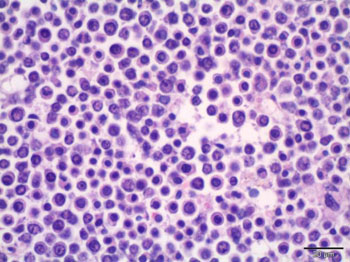New Multiple Myeloma Mouse Model Should Advance Drug Development Efforts
By LabMedica International staff writers
Posted on 18 May 2016
A recently developed multiple myeloma mouse model is expected to aid in understanding the pathology of the disease and serve as a platform for preclinical testing of potential therapeutic agents.Posted on 18 May 2016
Investigators at the University of Miami School of Medicine (FL, USA) created the model by crossing two lines of genetically engineered mice. The first line (Mef−/−) lacked the gene for the transcription factor Mef (Elf4), which is known to both promote and suppress the formation of cancers. The second line (Rad50s) contained a mutation in a component of a sensor of DNA damage and regulator of DNA damage response pathways.

Image: A photomicrograph showing multiple myeloma cells in the bone marrow (Photo courtesy of the University of Miami School of Medicine).
The investigators reported in the March 10, 2016, online edition of the journal Scientific Reports that about 70% of the hybrid Mef−/−Rad50s/s mice died from multiple myeloma or other plasma cell cancers.
These mice initially showed an abnormal plasma cell proliferation and monoclonal protein production, and then developed anemia and a decreased bone mineral density. Tumor cells could be serially transplanted. Genome mapping and whole exome sequencing revealed that the pathogenesis of plasma cell cancers in these mice was not linked to activation of a specific oncogene, or inactivation of a specific tumor suppressor (except Mef).
"Multiple myeloma is the second most common hematologic malignancy in the U.S. and it is a very complex disease," said senior author Dr. Stephen D. Nimer, professor of medicine, biochemistry, and molecular biology at the University of Miami School of Medicine. "So far, there have not been animal models of malignant plasma-cell diseases that allow us to study their stepwise progression and fully understand the complex cellular mechanisms. Now that we have a proper model of the disease, we will be able to more effectively study multiple myeloma as well as potential treatments."
"Although outcomes for multiple myeloma patients have greatly improved, it remains an incurable disease, despite the availability of newer treatments," said Dr. Nimer. "Several animal models of multiple myeloma have been reported, including models of human myeloma cells. However, these models imperfectly mimic the human disease. Developing more-reliable and accurate animal models that help us better understand myeloma and test new treatments will take us to the next level on the long and challenging road to a cure."
Related Links:
University of Miami School of Medicine









 assay.jpg)



